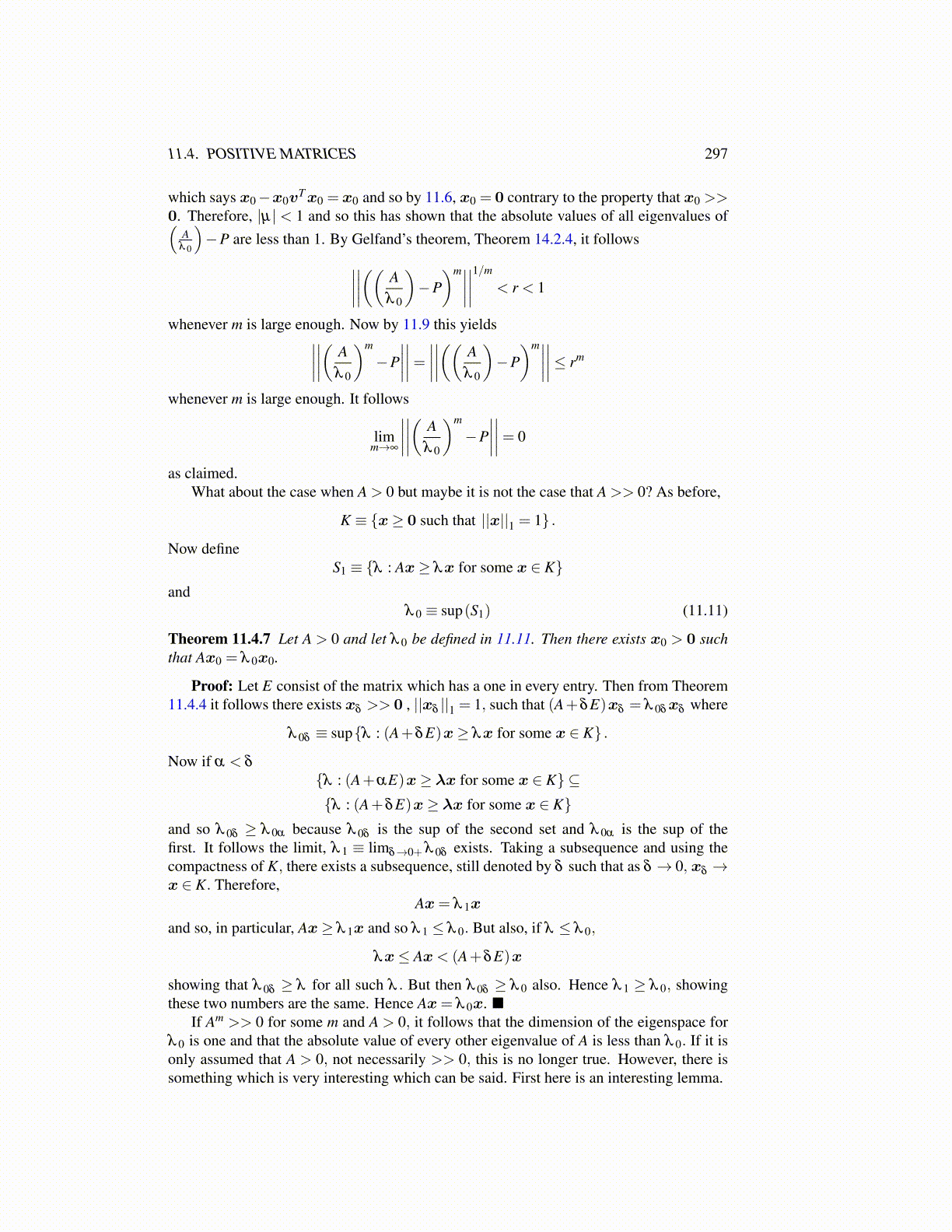
11.4. POSITIVE MATRICES 297
which says x0−x0vTx0 = x0 and so by 11.6, x0 = 0 contrary to the property that x0 >>
0. Therefore, |µ| < 1 and so this has shown that the absolute values of all eigenvalues of(A
λ 0
)−P are less than 1. By Gelfand’s theorem, Theorem 14.2.4, it follows∣∣∣∣∣∣∣∣(( A
λ 0
)−P)m∣∣∣∣∣∣∣∣1/m
< r < 1
whenever m is large enough. Now by 11.9 this yields∣∣∣∣∣∣∣∣( Aλ 0
)m
−P∣∣∣∣∣∣∣∣= ∣∣∣∣∣∣∣∣(( A
λ 0
)−P)m∣∣∣∣∣∣∣∣≤ rm
whenever m is large enough. It follows
limm→∞
∣∣∣∣∣∣∣∣( Aλ 0
)m
−P∣∣∣∣∣∣∣∣= 0
as claimed.What about the case when A > 0 but maybe it is not the case that A >> 0? As before,
K ≡ {x≥ 0 such that ||x||1 = 1} .
Now defineS1 ≡ {λ : Ax≥ λx for some x ∈ K}
andλ 0 ≡ sup(S1) (11.11)
Theorem 11.4.7 Let A > 0 and let λ 0 be defined in 11.11. Then there exists x0 > 0 suchthat Ax0 = λ 0x0.
Proof: Let E consist of the matrix which has a one in every entry. Then from Theorem11.4.4 it follows there exists xδ >> 0 , ||xδ ||1 = 1, such that (A+δE)xδ = λ 0δxδ where
λ 0δ ≡ sup{λ : (A+δE)x≥ λx for some x ∈ K} .
Now if α < δ
{λ : (A+αE)x≥ λx for some x ∈ K} ⊆{λ : (A+δE)x≥ λx for some x ∈ K}
and so λ 0δ ≥ λ 0α because λ 0δ is the sup of the second set and λ 0α is the sup of thefirst. It follows the limit, λ 1 ≡ limδ→0+ λ 0δ exists. Taking a subsequence and using thecompactness of K, there exists a subsequence, still denoted by δ such that as δ → 0, xδ →x ∈ K. Therefore,
Ax= λ 1x
and so, in particular, Ax≥ λ 1x and so λ 1 ≤ λ 0. But also, if λ ≤ λ 0,
λx≤ Ax< (A+δE)x
showing that λ 0δ ≥ λ for all such λ . But then λ 0δ ≥ λ 0 also. Hence λ 1 ≥ λ 0, showingthese two numbers are the same. Hence Ax= λ 0x. ■
If Am >> 0 for some m and A > 0, it follows that the dimension of the eigenspace forλ 0 is one and that the absolute value of every other eigenvalue of A is less than λ 0. If it isonly assumed that A > 0, not necessarily >> 0, this is no longer true. However, there issomething which is very interesting which can be said. First here is an interesting lemma.